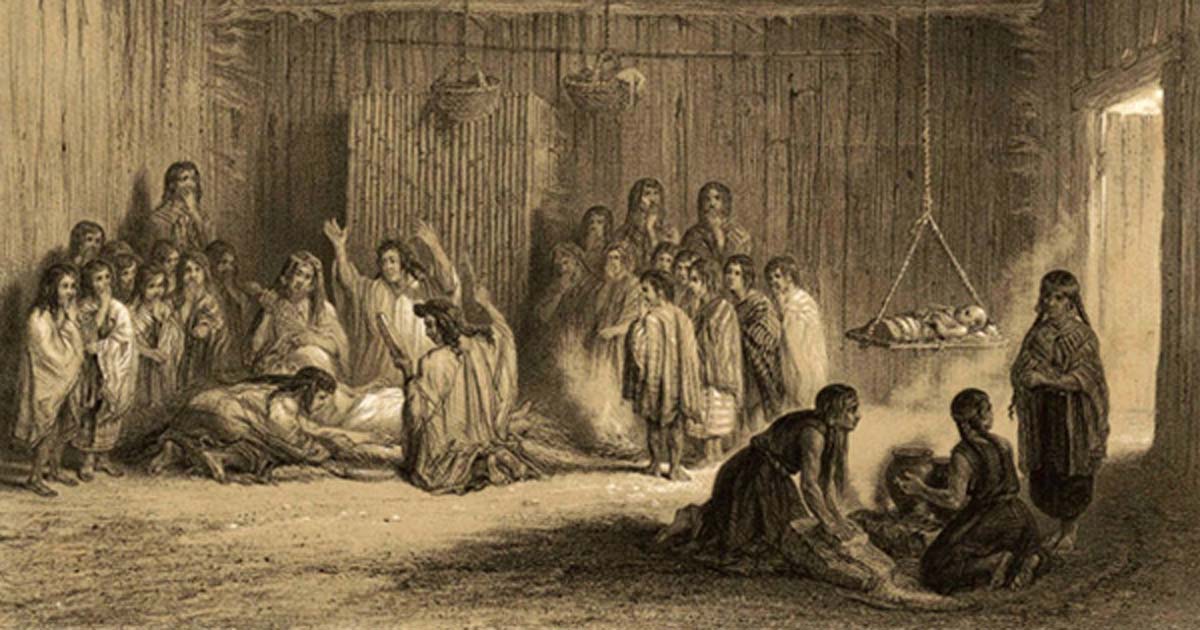Lethal Effects of Ancient Tobacco Consumption Identified in the Miscarried Baby of a Shamaness
2,400 years ago a shamaness suffered a miscarriage. The remains of that baby were found in a rock shelter in Northern Chile and have the earliest known traces of ancient tobacco found in biological remains in the Americas. Researchers suspect the high consumption of tobacco led to the baby’s sudden death.
The Burial of a Baby
A team of Chilean researchers have been studying the skeletal remains of the child that was unearthed in a rock shelter in the Upper Loa River area, 100 km (62.14 miles) north of the Atacama Basin. It was buried in a shallow, 70 cm (27.56 inch) deep grave with several grave goods. The baby had been clothed in a tunic, kilt and wool turban and was surrounded by mollusk shells from the Pacific Ocean, vegetable baskets, a pumpkin container, a textile bag, a stone projectile point, a copper pendant and copper beads. The child had received a rich burial for its time, providing an early indication for its family’s social status.

Objects associated to the perinate burial at Alero Ampahuasi – A16. 1. Lithic beads; 2. Copper metal pendant; 3. Wool turban (dated by 14C); 4. Lithic projectile point; 5. Fragments from spiral-technique basket (dated by 14C); 6. Pumpkin container. (Niemeyer et al. 2018)
When they analyzed the baby’s hair, the researchers discovered both nicotine and its product, cotinine, were in the child’s system at the time of death around 500 BC. Further analysis suggests the baby had received the nicotine through the placenta, meaning the child may have died suddenly pre-term or upon birth due to its mother’s overconsumption of tobacco during pregnancy. With such high quantities of nicotine found in the child’s hair, the researchers believe that the mother was probably a tobacco shamaness.
- Were the works of Shakespeare inspired by Cannabis? Scientists find traces of drugs on pipes
- Dealing in the Past: How Did Ancient Egyptians Get Nicotine and Cocaine?
- Astounding Find: Archaeologists Discover Mummy of an 18-week Fetus from Ancient Egypt
In their paper on the finding in the Journal of Archaeological Science, the scientists write, “Thus, at the dawn of pastoralism and agriculture in the highlands of the Atacama Desert, female individuals were already intensively consuming this psychoactive plant, transmitting its signals, and perhaps its lethal effects, to a child during gestation.”
Ancient Tobacco Usage in South American Shamanic Ceremonies
In Pre-Contact times, it is believed that tobacco primarily served a magical/spiritual/religious purpose and was used mostly in medicinal or healing practices or to induce trances. The huge quantities of tobacco consumed by South American shamans has been documented in several studies and ethnographic accounts. Some say that more than 100 cigarettes could be smoked in a single shamanic session. And in the indigenous Mapuche culture of Chile today, women still hold an important shamanic role as Machis, traditional healing women/shamans who lead significant religious ceremonies.

A Machi is a shaman or (usually) a good witch in the Mapuche culture of South America; and is also an important character and the Mapuche mythology. (Public Domain)
While the researchers acknowledge in their paper that there is little information available on the shamanic role of women in pre-Hispanic times, the high quantities of nicotine and cotinine found in the child’s remains support the idea that the baby’s mother probably held a shamanic role.
Researcher Javier Echeverria told Ancient Origins that the tobacco usage by the mother was “mainly for therapeutic and ritual purposes, although you cannot rule out a social or recreative consumption.” She probably used a pipe to smoke the psychoactive substance as this was a popular means to consume tobacco at the time.
- Experts Discover Hard Evidence that Native Americans were Smoking Tobacco 3000 Years Ago
- Researchers Take a Bite Out of Prehistoric Nicotine Use
- The Real Story of Shamanism: No Need to Don a Headdress or Take Hallucinogens

A Mapuche stone pipe. (Magenta)
Their findings also declare the baby as the “earliest and youngest passive tobacco consumer in the Americas.”
Continuing Research into Pre-Hispanic Psychoactive Substance Usage
The research team plans to continue on a similar path with future research. When asked what they plan to do next, Mr Echeverria told Ancient Origins, “Currently, our research is still aimed at deepening ritual practices incorporating other consumption patterns present in archaeological evidence such as tubes and snuff trays for the inhalation of psychotropic powders (very abundant in the area), as well as the presence of enema syringes. We are also investigating the consumption of fermented beverages in pre-Hispanic times.”
Top Image: Illustration of a machi healing a patient, from ‘Atlas of Physical and Political History of Chile’ (‘Atlas de la historia física y política de Chile’), by Claudio Gay. A machi is a Chilean traditional healer. Since ancient times, tobacco has been a popular substance used in shamanic practices in Chile. Source: Public Domain
Source: Niemeyer, H., de Souza, P., Camilo, C., & Echeverria, J. (2018). Chemical evidence of prehistoric passive tobacco consumption by a human perinate (early Formative Period, South-Central Andes). Journal of Archaeological Science, Vol 100, pgs 130-138.



















